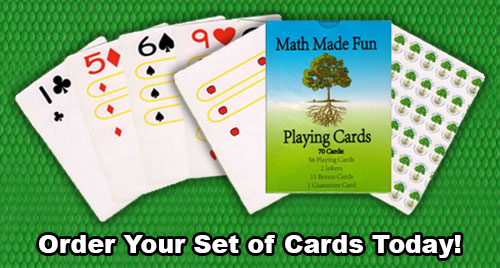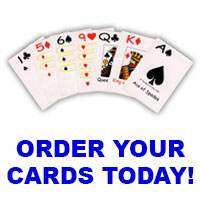Math Made Fun through Playing Cards
The Merritt Way Playing Cards are unique. The set contains 56 cards, and they reinforce the concept of pairs and base ten. The J, Q, K and A are all spelled out along with hearts, spades, diamonds, and clubs. The set of cards include the ‘1’ cards. Pairs are circled in yellow, which reinforces the concepts of odds and evens. The ‘9’ will not be curvy- but it will be a ‘straight stick nine’ the way you probably write it. The images are to be viewed only an upright position. With The Merritt Way apple trees on the back of the cards, a parent will be able to glance at how the child is holding the cards and make sure the green side of the trees is upright and the roots of the trees are going down. These are custom made strong, durable 2.5 X 3.5 inch playing cards. This is a great way to improve math, working memory, and socialization skills.
Basics
- Must learn to write the numbers the correct way (Step 1 “A Time for Phonics” book or Photo Flashcards shows you how to do numbers & letters)
- Must learn the two most important numbers in math are 2 and 10
- Must recognize odds and evens in a flash of a moment
- Will learn to do the dot-map quantities of 1-10 in vertical index card space
Use the hearts 1-10 cards. This exercise is good to strengthen eye-hand pincer grip. Place cards with hearts lined up across table in sequential manner.
1–2–3–4–5–6–7–8–9–10
Place dominant hand flat and centered on table. Instructor calls out a number, “Five”, and the student repeats the number when he/she points below the card with a strong index finger while slapping the hand down flat again in center of table. Positioned and ready for next number, the instructor does a set of 10 numbers; the student does a set of 10 numbers. Repeat this exercise daily until perfected.
Use the hearts 1-10 cards to flash in front of the child in a sweeping motion. Do 1-6, 1-8, then master 1-10.
Goal: instant recognition of the number and instant recognition of odd or even. Repeat this exercise daily until perfected.
Use any set 1-10 to practice copying the quantities of 1-10 using just simple dots, in a left to right, top down manner. Use a different color circle the pairs. Start at the center top and going in the same direction as the letter C to make the circle. Repeat this exercise daily until perfected.
Use any set of the 1-10 cards to flash in front of child in a sweeping motion. Do 1-10, and then have student describe the card such as “3 pairs with 1 left over is a 7.”
Goal: instant recognition of the number and instant recognition of odd or even. Repeat this exercise daily until perfected.
Some Fun Card Games
Go Fish: Play to win. If you need to learn how to play the game go to: http://www.bicyclecards.com/card-games/rule/go-fish
War: Play to win. If you need to learn how to play the game go to: http://www.bicyclecards.com/card-games/rule/war
Simple Concentration: Play Concentration with the possible combination of four pairs of two matching cards by color. It could be sets of red Jacks, black 9s, red 2s, black 5s. Lay out in a three by three format with the center space left blank. Play against each other, but play in a sequential manner. Turn cards over in a left to right, top down manner, instead of doing this the random way. Play to win.
Concentration: Play Concentration with eight pairs of two matching cards by color. It could be sets of red 6s, black Queens, red Kings, black Aces, red 3s, black 4s, red 10s, black 8s. Lay out in a four by four format, going left to right, top down manner as you lay them down. Play against each other, but play in a sequential manner. Turn cards over in a left to right, top down manner, instead of doing this the random way. Play to win.
Play Addition War: Each player pulls two cards from center deck. Then the player lays down two cards left to right, names the numbers, (face cards equal 10, Ace equals 11) and adds. The individual with the highest sum wins that round and takes all the cards. If there is a tie, each person takes three cards and then the next two cards they sum. The winner takes all. Continue the game until whoever has the most cards at a preset time wins.
Play Multiplication War: Each player pulls two cards from center deck. Then the player lays down two cards left to right, names the numbers, (face cards equal 10, Ace equals 11) and multiplies. The individual with the highest product wins that round and takes all the cards. If there is a tie, each person takes three cards and then the next two cards and multiplies them. The winner takes all. Continue the game until whoever has the most cards at a preset time wins.
Play Subtraction War: Each player pulls two cards from center deck. The player chooses the larger number and subtracts the smaller number to find the difference. Face cards equal 10 and Ace equals 11. The individual with the lowest difference wins that round and takes all the cards. If there is a tie, each person takes three cards and then the next two cards and finds the difference. The winner takes all. Continue the game until whoever has the most cards at a preset time wins.
Play Division War: Each player pulls two cards from center deck. The player arranges the cards in a manner to form a fraction. So 2 over a Jack, would be 2/10 reduced to 1/5. You could play that whoever has the highest fraction or the lowest fraction is the winner. If there is a tie, each person takes three cards and then the next two cards they find the fraction. Continue the game until whoever has the most cards at a preset time wins.
Make the Most of It: Remove face cards and Aces from the deck. Players take turns drawing one card at a time, trying to create the largest 5 digit number possible. As each card is drawn, it is placed (and cannot be moved) into the ones, tens, hundreds, thousands, or ten-thousands place. When the sixth card is drawn, the player can choose one of the cards on the table to discard and replace it with the sixth card. The largest 5 digit number wins. Make this game easier or harder by varying the number of digits.
Black Jack: Use all 56 cards. If you need to learn how to play the game go to: http://www.bicyclecards.com/card-games/rule/blackjack
Solitaire: Use all 56 cards. If you need to learn how to play the game go to: http://www.bicyclecards.com/card-games/rule/klondike
Here are 4 games from with slight modifications: http://www.pedagonet.com/quickies/acingmaths.pdf
Hit (Grades 5 – 8)
This game is for groups of two or more people. You will need to remove the Aces and face cards.
Skill: Number recognition, addition, subtraction, multiplication, positive integers, negative integers, and mathematical reasoning.
How to Play: Black cards are positive numbers; red cards are negative numbers. For each player, turn one card face down and one card face up. Everyone can see the face-up card, but only the player gets to look at his/her face-down card (until the end of the game when all cards are revealed).
The goal of the game is to get as close to zero as possible.
Player 1 Player 2
Each player adds his/her cards together in their head. Then he/she may ask for up to 5 “hits,” or extra cards, that are dealt face up, for a maximum of seven cards total.
Player 1: asked for 3 hits, total is 0
-7 + -2 = -9 + 8 = -1 + -3 = -4 + 4 = 0
Player 2: asked for 1 hit, total is 2
10 + -1 = 9 + -7 = 2
Player 1 is closest to zero, so he/she won that round.
When everyone is done asking for hits, all cards are turned face up. Whatever each player’s cards add up to is his/her score. Whoever scores closest to zero when all of the cards are revealed wins that round and becomes the dealer for the next round.
Over-Under (Grades 3 – 6)
Materials: Deck of cards with face cards and aces removed.
Skill: Multiplication
How to Play: Players split a deck of cards. One player is the Under 30 player and the other is the Over 30 player.
Player 1: Under 30 Player 2: Over 30 The product is under 30. Player 1 keeps the cards.
Each player turns over a card at the same time and the two numbers are multiplied together. If the product is less than 30, the Under 30 player keeps the cards. If the product is greater than 30, the Over 30 player keeps the cards. If the answer is exactly 30 each player takes back his/her card and places it back in the deck. When all the cards have been used, the person with the most cards wins.
First to Fifty Addition (Grades 2 – 5)
Players: Groups of two or more
Materials: Deck of cards, Ace worth 11, Jack worth 12, Queen worth 13, King worth 14
Skill: Addition
How to Play: Deal two cards to each player. Each player then turns over the two cards they have been given and determines the sum.
Player 1: sum is 7 Player 2: sum is 19 Player 3: sum is 11. The greatest sum is 19, so player 2 keeps their cards.
The player with the largest sum keeps their two cards while the other cards are returned to the bottom of the deck and new hands are dealt again. Players total the value of the cards they have won until one player is the first to fifty (or higher).
Give Some Percent! (Grades 4 – 6)
Players: Groups of two or more
Materials: Deck of cards, Ace worth 11, Jack worth 12, Queen worth 13, King worth 14, scratch paper
Skill: Percentages and division
How to Play: Shuffle the cards and place the deck face down in the center of the table. Decide on a percent for the first game. For example, let’s use 50%.
Turn over the top card. Players race to find the given percentage (50%) of the value of the card. (Let’s say it is a four of spades.) The first player that can give a correct answer wins the card. (In this example, 50% of 4, would be “2.”)
Play until the deck or time runs out. The player with the most cards wins. In the case of an odd number, have students use decimals or fractions to represent the answer (50% of 11 is 5.5 or 5 ½). Allow the winner of each round to determine the percent for the next round.



